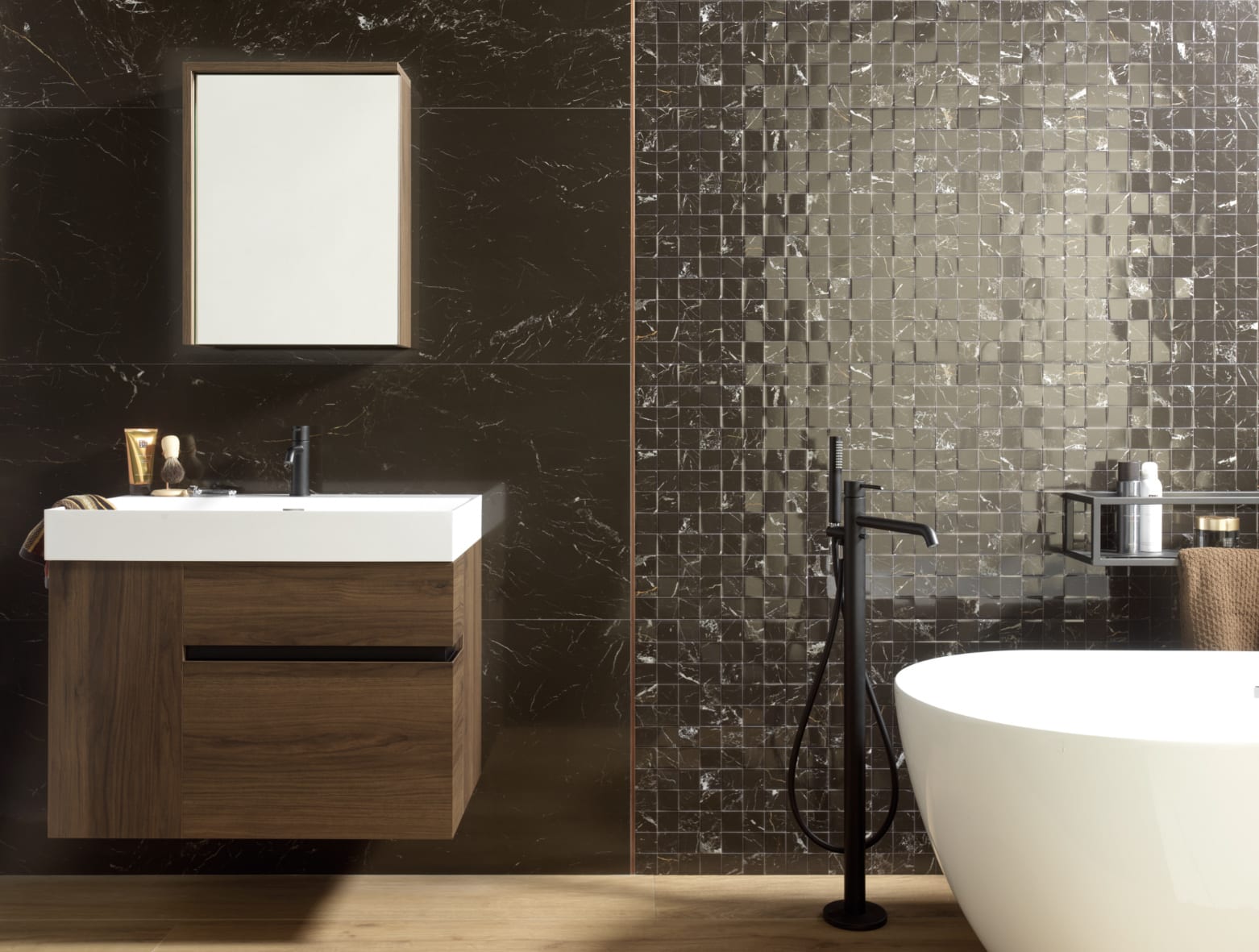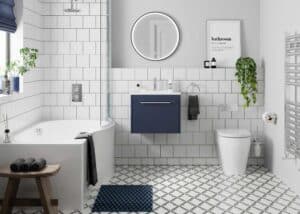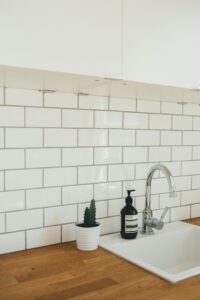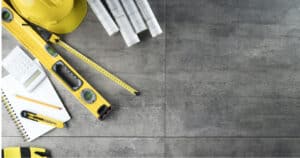Understanding Bathroom Installation
Before deciding between a DIY approach or hiring professional fitters for your bathroom installation, one must first understand what the process entails.
The Process of Bathroom Installation
Bathroom installation is a complex undertaking that involves a series of steps. It typically starts with the removal of the existing fixtures and finishes. This is followed by the preparation of the room for new installations, which may include tasks such as plumbing modifications, electrical wiring adjustments, and drywall repairs.
Next, the new fixtures are installed, starting with the bathtub or shower, followed by the toilet and sink. The walls, flooring, and ceiling are then finished, and the final details such as lighting, mirrors, and accessories are added.
Each of these steps requires a different set of skills and tools, and missing a single step could potentially lead to functionality issues or unsatisfactory results. For a more detailed look at what to expect during the bathroom installation process, check out our guide on what to expect during the bathroom installation process.
Key Parts of a Bathroom Installation
A comprehensive bathroom installation involves several key parts:
- Planning and Design: This is the stage where you decide on the layout, choose the fixtures and finishes, and create a detailed plan for the installation. For tips on designing your bathroom, check out our article on the latest trends in bathroom design.
- Demolition and Preparation: The existing fixtures and finishes are removed, and the space is prepared for the new installations. This may involve plumbing and electrical work, as well as repairs to the walls, ceiling, and floor.
- Installation of Fixtures: The new bathtub or shower, toilet, and sink are installed. This step requires precision and skill to ensure that the fixtures function properly and are securely attached.
- Finishing: The walls, floor, and ceiling are finished, often with tile, paint, or wall panels. Then, the final details such as lighting, mirrors, and accessories are added.
- Cleanup and Inspection: The space is cleaned, and the installation is inspected to ensure that everything has been done correctly and the new bathroom is ready for use.
Whether you choose to undertake this endeavor on your own or hire bathroom installers & fitters, understanding the process and its key parts will help you to better manage the project and ensure a successful outcome.
The DIY Approach
When it comes to bathroom installation, many people choose to take the Do-It-Yourself (DIY) route. This approach offers several benefits but also comes with its share of challenges and risks.
Skills and Tools Needed for DIY Bathroom Installation
A successful DIY bathroom installation requires a certain level of skill and knowledge in various areas such as plumbing, tiling, electrical work, and carpentry. Familiarity with building codes and regulations is also essential to ensure the installation meets safety standards.
Additionally, several tools are necessary for a bathroom installation project. These include, but are not limited to, a tape measure, level, pipe cutter, drill, wrench, pliers, and safety gear.
| Skills | Tools |
|---|---|
| Plumbing | Pipe Cutter |
| Tiling | Tile Cutter |
| Electrical Work | Voltage Tester |
| Carpentry | Hammer |
For a comprehensive guide on the bathroom installation process, refer to our article what to expect during the bathroom installation process.
Advantages of DIY Bathroom Installation
One of the main advantages of DIY bathroom installation is the potential for cost savings. By eliminating labor costs, the overall expense of the project can be significantly reduced.
DIY also offers a sense of personal satisfaction. Completing a bathroom installation project can be a rewarding experience, providing a sense of accomplishment and the opportunity to customize the space according to personal preferences.
Lastly, DIY projects offer flexibility. You can work at your own pace and make changes as needed without having to coordinate with a professional fitter.
Challenges and Risks of DIY Bathroom Installation
Despite the potential advantages, DIY bathroom installation also comes with challenges and risks. One of the main challenges is the time commitment. Bathroom installations can be time-consuming, especially for those who are new to DIY projects.
There’s also the risk of making mistakes, which can lead to additional costs and delays. Without professional guidance, issues such as improper sealing, incorrect plumbing connections, or faulty electrical wiring can easily occur.
Moreover, performing DIY installations without the necessary skills or knowledge can lead to safety concerns. Therefore, it’s crucial to thoroughly research and prepare before undertaking a DIY bathroom installation project.
For more information on common challenges in bathroom installations and how to overcome them, check our article on common challenges in bathroom installation and how to overcome them.
In conclusion, while the DIY approach to bathroom installation has its advantages, it also comes with significant challenges and risks. It’s crucial to weigh these factors carefully before deciding on the DIY route.
The Professional Approach
When it comes to bathroom installation, hiring professional fitters can offer a range of benefits. This section will delve into what professional fitters bring to the table, the advantages of hiring them, and key considerations when seeking their services.
What Professional Fitters Bring to the Table
Professional bathroom fitters are equipped with the necessary skills, training, and experience to handle every aspect of bathroom installation. They have a deep understanding of the technical aspects associated with plumbing, electrical wiring, and structural elements, ensuring a safe, efficient, and high-quality installation.
Additionally, professional fitters are adept at troubleshooting and overcoming common challenges that can arise during the installation process. Their comprehensive knowledge of current design trends, innovative products, and efficient installation techniques can prove invaluable in creating a bathroom that is both functional and aesthetically pleasing. For a deeper look into what professional fitters can offer, check out our complete guide to professional bathroom fitting services.
Advantages of Hiring Professional Fitters
Hiring professional fitters for your bathroom installation can offer several advantages:
- Efficiency and Speed: Professional fitters have the skills and experience to complete the job efficiently, minimizing disruptions to your daily routine.
- Quality and Precision: Professionals are trained to adhere to high standards of quality and precision, ensuring that the final result is both durable and attractive.
- Compliance with Regulations: Professional fitters are knowledgeable about local building codes and regulations, ensuring that your bathroom installation meets all legal requirements.
- Reduced Stress: Hiring a professional eliminates the need for you to handle the task yourself, reducing stress and freeing up your time for other activities.
For more insights, visit our article on top tips from expert bathroom fitters: ensuring quality installations.
Considerations When Hiring Professional Fitters
When hiring professional fitters for bathroom installation, there are several factors to consider:
- Credentials and Experience: Verify that the fitters have the necessary training, credentials, and experience for bathroom installations. Check out our article on evaluating bathroom fitters: credentials and experience matter.
- Cost: Obtain multiple quotes from different fitters to ensure that you’re getting the best value for your money. Our guide on bathroom fitting costs: budgeting for your renovation project can help you understand the cost involved.
- Reviews and References: Check reviews and ask for references to assess the quality of the fitter’s work and their reputation among previous clients.
Before hiring, it’s crucial to ask the right questions to ensure that the fitter can meet your specific needs and expectations. Check out our guide on essential questions to ask before hiring bathroom fitters for more details.
Comparing DIY vs. Professional Bathroom Installation
Making the decision between DIY and hiring professional fitters for a bathroom installation can be challenging. It’s important to consider several factors, including the time and effort required, the cost involved, and the expected quality and longevity of the installation.
Time and Effort
A significant difference between DIY and hiring professional fitters lies in the time and effort needed. DIY bathroom installations can be time-consuming, particularly for those unfamiliar with the process. It involves not just the physical labor but also the planning, sourcing of materials, and troubleshooting any issues that may arise. On the other hand, hiring professional bathroom installers & fitters can significantly reduce the time and effort required from the homeowner, as they handle everything from planning to execution and cleanup.
Cost
Cost is another crucial factor to consider. A DIY approach can potentially save money, as you’re avoiding the labor costs associated with hiring professionals. However, it’s important to factor in the costs of tools and materials, as well as the potential for additional expenses due to mistakes or unforeseen complications.
Conversely, while hiring professional fitters might have higher upfront costs, these often include warranties or guarantees on the work, providing peace of mind and potentially saving money in the long run. Our guide on bathroom fitting costs: budgeting for your renovation project can provide further insights.
Quality and Longevity
The quality and longevity of a bathroom installation can also vary greatly between DIY and professional jobs. DIY installations, especially by those without significant experience, can often lead to lower quality results and potential issues down the line. This could result in additional costs for repairs or replacements in the future.
Professional fitters, on the other hand, have the knowledge, experience, and tools to ensure a high-quality installation that will stand the test of time. They’re also up-to-date with the latest trends in bathroom design and can offer advice on the best materials and techniques to use.
In conclusion, the decision between DIY and professional bathroom installation depends on individual circumstances, including the complexity of the project, the budget, and the homeowner’s skills and confidence in tackling the job. Both options have their pros and cons, and it’s crucial to weigh these against your specific needs and capabilities before making a decision.
Making the Right Decision
Choosing between a DIY approach and hiring professional fitters for your bathroom installation is not a decision to be taken lightly. It requires assessing your skills and resources, considering the complexity of the project, and weighing the costs against benefits.
Assessing your Skills and Resources
Before embarking on a DIY bathroom installation, it’s imperative to assess your skills and resources. Ask yourself the following questions:
- Do you have the necessary skills and knowledge to handle the installation?
- Do you have the right tools and equipment?
- Can you manage the time and effort required for the project?
If you’re confident about your abilities, a DIY approach might be suitable for you. However, if there are any doubts, it may be wise to consider hiring professional bathroom installers and fitters.
Considering the Complexity of the Project
The complexity of the bathroom installation project is another significant factor to consider. Simple tasks like replacing faucets or installing a new mirror could be tackled personally. But when it comes to more complex jobs like installing a new bathtub, plumbing, or electrical work, professional help might be necessary.
It’s important to understand what the project entails and whether you’re equipped to handle any unexpected challenges that might arise. Our guide on common challenges in bathroom installation and how to overcome them can be a helpful resource in this regard.
Weighing Costs against Benefits
While DIY bathroom installation can save money upfront, it’s important to consider the long-term costs and benefits. If a job is done incorrectly, it might end up costing more in repairs and replacements down the line.
On the other hand, hiring professional fitters might involve a higher initial cost but could save money in the long run by ensuring a quality job that lasts for years. Professionals also tend to complete the job faster, saving you valuable time.
| Approach | Costs | Benefits |
|---|---|---|
| DIY | Lower upfront cost, potential future repair costs | Savings on labor, personal satisfaction |
| Professional Fitters | Higher upfront cost | Quality work, saves time, potential long-term savings |
Making the right decision for your bathroom installation involves a thorough evaluation of your situation. Whether you choose DIY or hire professional fitters, it’s important to make an informed decision that aligns with your skills, resources, and project needs. For more insights, check out our articles on evaluating bathroom fitters: credentials and experience matter and bathroom fitting: understanding the time and cost involved.




